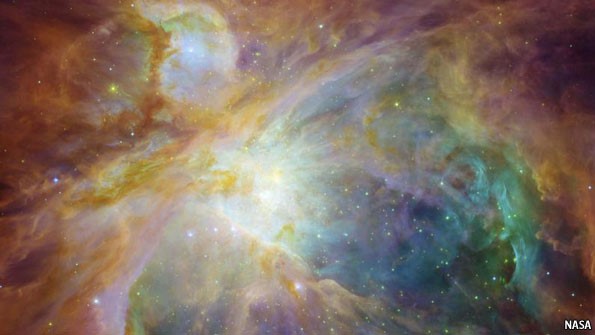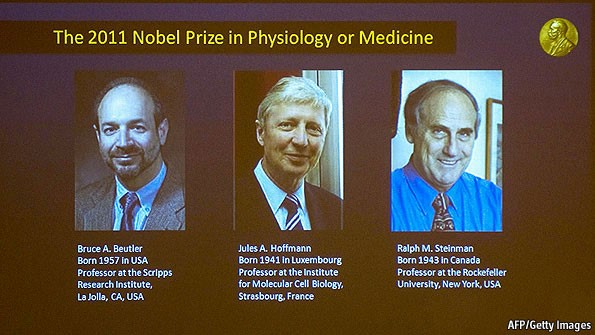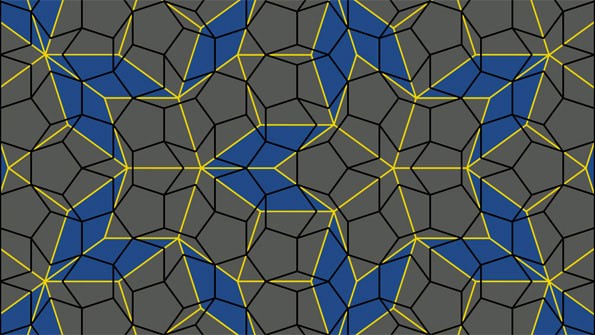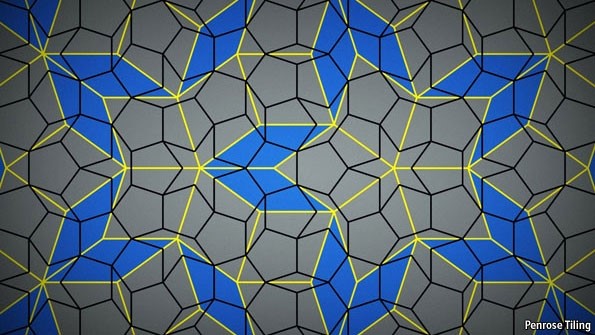

 字體:小 中 大
字體:小 中 大 |
|
|
|
| 2018/03/05 15:20:05瀏覽64|回應0|推薦0 | |
The 2011 Nobel prize for physicsExpanding horizonsOct 4th 2011, 12:39 by G.C.
This was worked out by two groups who, in the 1990s, were studying exploding stars called supernovae. One was the Supernova Cosmology Project, at the University of California, Berkeley, led by Saul Perlmutter. The other was the High-z Supernova Search Team, an international project led by Brian Schmidt and involving Adam Riess, both of Harvard University. It is these three gentlemen who have shared the prize. Supernovae come in various types. One particular sort, though, known as type Ia supernovae, always explode with about the same energy and are therefore equally bright. That means they can be used to estimate quite precisely how far away they (and thus the galaxy they inhabit) are. In addition, the speed at which an object such as a star or galaxy is moving away from Earth, because of the expansion of the universe, can be worked out from its red-shift. This is a fall in the frequency of its light towards the red end of the spectrum. It is caused by the Doppler effect (something similar happens when a police car or fire engine with its siren blaring drives past you, and the pitch of the sound suddenly drops). What both groups found was that the light from distant supernovae was fainter than predicted. In other words, the supernovae were further away than their red-shifts indicated they should be, based on the existing model of the universe. Something, then, was pushing space itself apart. What that something is, remains conjecture. It has been labelled "dark energy", but that is really physicists short-hand for "we havent got a clue". It may, though, relate to a mathematical term called the cosmological constant that appears in Einsteins general theory of relativity, and which Einstein thought, before the discovery of the expansion of the universe, was necessary to stop the universe collapsing. · 14 · inShare2 Expanding horizons Oct 4th 2011, 16:17 I have heard of this new discovery from the introduction of Japan’s Newton Magazine in the late 1990s when I was only a junior high student and have studied this phenomenon in the previous edition of senior high textbook by Taiwan’s National Edition and Translating Building.
The measured frequency number from both teams indicated not only the continuous expansion but also the appearance of newly-formed object (although the real time point of occurrence takes some time of running light into calculation, for us it’s new). The collection of these data can help rationalize as well as improve the clearance of both historic critical point and the experience of all the universe. The key formula is Doppler Effect which says the ratio of relative speed and absolute frequency is the same when two or the above objects are compared in order to test the individual frequency, in my words.
Supernovae is still questionable because some evidences show the discrepancy between the existence stars or others and the possible disappearance of galaxy. Given the consideration of antimatter or whether anything is faster than light, the cause of “dark energy” is step by step proved. So we had better hold conservative views on this issue.
In China, there are numerous researchers donating in this issue concerned. Starting from then China’s national chairman Jiang Ze-Min enchanting “the progress of scientific education must increase the wealthy power of country”, many youngers study the relative domain exploring the know-how in this universe rapidly for at least twenty years along with Lu Yun-Shiang and Tswei Chi who is also a Nobel Physics laureate. I am one of these students who have ever interested this, still remembering some reports concerned of Adam Riess’ new finds which once impressed me very much from the faraway Newton Magazine. Taiwan who gradually lacks of the notion of democracy and law-system only to be neglected by this world. China is the only country that increases the budget to develop the space plan from military use to scientific research. To take responsibilities for this universe is to make good utility of the theory from Planck function to the emerging discovery.
Recommended 15 Report Permalink 每一年的經濟學人雜誌都會報導除了和平獎以外的其他獎項的簡述,筆者自今年起都會朝聖一次不忘前事。經濟學人編輯這幾年先搶在Babbage部落格發文,在這篇文末有附當期印刷版的正文。
筆者在讀建中時是自然組的,在此前有閱讀牛頓雜誌數年,當年看到這篇諾貝爾物理學獎有關超新星加速擴張現象的得獎報導,聯想到1998-1999年日本科學界最重視的太空科學是探索宇宙起源之謎。當時也是流行,牛頓出版公司的這套和從集英社代理的漫畫中國及世界的歷史,及附帶後來的中國科學院的沒看幾本的院士科普系列。中國大陸在江澤民時期就作科普的教育,並不落人後,中國科學家除了院長路甬祥(Yahoo直播新聞名主播路怡珍的親戚)、及崔琦(1998年諾貝爾物理學獎因穿隧效應發現而得獎之得主),後來數年的確多了許多中國出生的得主。崔琦是第六位華人,也第一個在香港接受教育的諾貝爾科學獎得主,他的得獎當年除了美國僑界,也很受香港各界的喜愛。(http://hn.ifeng.com/zixun/fengyanguanyu/detail_2014_04/23/2171516_0.shtml) 江澤民提科教興國,全社會都應該要參與言猶在耳。筆者裡面有一句是仿造:With a slogan of "wealth and power", the Jiang administration hopes to double the gross national product in 2010 from the level in 2000. (例解英文商業核心用語,GNP的例句,菊地義明編著)
欲測得頻率f,可以藉都卜勒公式來推論,並作校正。從外太空傳回來的波長λ ,顯示在光譜上。都卜勒公式即為兩個物體相對於介質的速度(以向量式表示)除以物體(或光)的本身頻率,λ為定值來推估的。即v=f*λ 的快樂應用。所測得的f作時間序列收集,以推估欲求的形態,再來推測那遠在千里之外,肉眼看望遠鏡底下極渺小的物體,星體(或是外太空生物?)
這年的諾貝爾官方網站:https://www.nobelprize.org/nobel_prizes/physics/laureates/2011/ 其他兩篇生理醫學獎及化學獎的報導: The 2011 Nobel prize for medicineSeeking immunityOct 3rd 2011, 12:30 by G.C.
ONE of the fixed points in the scientific calendar is the announcement, in early October, of the Nobel prizes for chemistry, physics and physiology or medicine. Like politicians eager for ministerial office after an election, scientists who imagine their work might qualify hover discreetly near the telephone awaiting a call from Stockholm. Tradition dictates that the prize for medicine is announced first, and this year it went to three immunologists. Two, Bruce Beutler, from America, and Jules Hoffmann, from Luxembourg, shared half the prize (5m crowns, or about $730,000) for related work on the way the immune system boots up in the face of invading pathogens. Dr Hoffman found in fruit flies, and Dr Beutler subsequently discovered in mice, a crucial protein-binding mechanism that helps the immune system recognise invaders and trigger an immune response against them. The other 5mcrowns went to Ralph Steinman, from Canada, who discovered the role of dendritic cells in activating some of the immune systems main cellular troops, known at T-lymphocytes. Or, rather, it would have done, had Dr Steinman not died on September 30th. The posthumous announcement of a Nobel prize is not supposed to happen, because the rules dictate that it can only be awarded to living scientists. Whether the Karolinska Institute, which decides on the winner, was aware of Dr Steinmans death when it made its choice is unclear, but the announcement of Dr Steinmans award made no mention of his death. Update: The Karolinska Institute has issued a statement saying that Dr Steinman will retain his prize: "According to the statutes of the Nobel Foundation, work produced by a person since deceased shall not be given an award. However, the statutes specify that if a person has been awarded a prize and has died before receiving it, the prize may be presented...the decision to award the Nobel Prize to Ralph Steinman was made in good faith, based on the assumption that the Nobel Laureate was alive. This was true – though not at the time of the decision – only a day or so previously...The decision made by the Nobel Assembly at Karolinska Institute thus remains unchanged." · Recommended · 86 · inShare8 The 2011 Nobel prize for chemistryCrystal tipsOct 5th 2011, 12:00 by G.C.
UNLIKE the medicine and physics prizes, the chemistry prize this year went to an individual. The winner was Daniel Shechtmanof Technion, a technology institute in Haifa. On April 8th 1982 Dr Shechtman fired a beam of electrons at a slice of aluminium-manganese alloy, in order to understand its crystal structure. Electrons, being waves as well as particles, produce a diffraction pattern when transmitted through a crystal. Analysis of that pattern can tell you the details of how a crystals atoms are arranged. One of the most basic parts of that arrangement, though, is immediately obvious from the picture of spots in the pattern. This is the order of symmetry of the crystal (in other words, the number of ways it can be rotated to produce a pattern identical to the original). In this case the order of symmetry Dr Shechtman saw was tenfold. That is impossible. Geometry dictates that only two-, three-, four- and six-fold rotational symmetry can exist. At least, those are the possibilities if the material really is a crystal. What Dr Shechtman had discovered, he realised, was a new sort of material called a quasicrystal. Quasicrystals have regular elements, like normal crystals. But these elements fit together in ways which never properly repeat themselves. The two-dimensional equivalent is known as Penrose tiling (see picture), after Sir Roger Penrose, a British mathematician who put this form of geometry on a formal footing. Penrose tiling has, however, been widely used in the past for decoration, particularly by Islamic artists. The discovery of quasicrystals—in effect, three-dimensional Penrose tiles—has revolutionised materials science. Others, with eight- and 12-fold symmetry are now known. They often have interesting properties, such as poor heat conductivity (which makes them good insulators) and low friction (which makes them slippery). This makes them useful for certain sorts of coating. Liquid crystals, often used in display screens, are sometimes quasicrystals, too. And they have also turned up in a type of hard, specialised steel made by Sandvik, a Swedish engineering firm. Alfred Nobel, Swedens most famous industrialist, would have been proud. · 25 · inShare1 The 2011 Nobel prizesExpanding horizonsThis year’s prizes were awarded for work on the immune system, the expansion of the universe and quasicrystalsOct 8th 2011 | from the print edition
Endless variations on a theme
THE rules say it is not allowed. But this year a Nobel prize was awarded to a dead man. Ralph Steinman of Rockefeller University in New York, who discovered the role of dendritic cells in activating the immune system, died on September 30th. That news did not, however, make it across the Atlantic Ocean in time, and on October 3rd the Karolinska Institute in Stockholm honoured Dr Steinman with half of this years prize in physiology or medicine. The other half went to Bruce Beutler, from the Scripps Institute in San Diego, and Jules Hoffmann, from Strasbourg University, for work on the way the immune system boots up in the face of invading pathogens. Dr Hoffmann found in fruit flies, and Dr Beutler subsequently discovered in mice, a crucial protein-binding mechanism that helps the immune system recognise invaders and trigger an immune response against them. In this section This done, Dr Steinmans dendritic cells then stimulate some of the immune systems main cellular troops, known at T-lymphocytes, into action. Some T-cells go on to kill infected body cells. Some act as part of the immune systems memory, so that it can respond quickly to the recurrence of an infection. And some help regulate the activities of other cells in the immune system. Champagne supernovae The physics prize was awarded for what, in one sense, might reasonably be viewed as the biggest discovery ever made in that subject—that the universe is not only expanding (which had been known since the 1920s), but that the rate of expansion is increasing. Something, in other words, is actively pushing it apart. This was worked out by two groups who, in the 1990s, were studying exploding stars called supernovae. One was the Supernova Cosmology Project, led by Saul Perlmutter of the Lawrence Berkeley National Laboratory, in California. The other was the High-z Supernova Search Team, an international collaboration led by Brian Schmidt and involving Adam Riess, both then at Harvard University. It is these three gentlemen who have shared the prize. Supernovae come in various types. One particular sort, though, known as type Ia, always explode with about the same energy and are therefore equally bright. That means it can be estimated, with reasonable precision, how far away they are. In addition, the speed at which an object such as a star or galaxy is moving away from Earth, because of the expansion of the universe, can be worked out from its redshift. This is a fall towards the red end of the spectrum in the frequency of its light. It is caused by the Doppler effect (something similar happens when a police car or fire engine drives past you with its siren blaring, and the pitch of the sound suddenly drops). What both groups found was that the light from distant supernovae was fainter than predicted. In other words, the supernovae were farther away than their redshifts indicated they should be, based on the existing model of the universe. Something, then, was pushing space itself apart. What that something is, remains conjecture. It has been labelled “dark energy”, but that is really physicists shorthand for “we havent got a clue”. It may, though, relate to a mathematical term called the cosmological constant that appears in Einsteins general theory of relativity, and which Einstein thought, before the discovery of the expansion of the universe, was necessary to stop the universe collapsing. Crystal tips Unlike the medicine and physics prizes, the chemistry prize went to an individual. The winner was Daniel Shechtman of Technion, a technology institute in Haifa, Israel. On April 8th 1982 Dr Shechtman fired a beam of electrons at a slice of aluminium-manganese alloy, in order to understand its crystal structure. Electrons, being waves as well as particles, produce a diffraction pattern when transmitted through a crystal. Analysis of that pattern can tell you the details of how a crystals atoms are arranged. One of the most basic parts of that arrangement, though, is immediately obvious from the picture of spots in the pattern. This is the order of symmetry of the crystal (in other words, the number of ways it can be rotated to produce a pattern identical to the original). In this case the order of symmetry Dr Shechtman saw was tenfold. That is impossible. Geometry dictates that only two-, three-, four- and sixfold rotational symmetry can exist. At least, those are the possibilities if the material really is a crystal. What Dr Shechtman had discovered, he realised, was a new sort of material called a quasicrystal. Quasicrystals have regular elements, like normal crystals. But these elements fit together in ways which never properly repeat themselves. The two-dimensional equivalent is known as Penrose tiling (see picture above), after Sir Roger Penrose, the mathematician who put this form of geometry on a formal footing. Penrose tiling has, however, been widely used in the past for decoration, particularly by Islamic artists. The discovery of quasicrystals—in effect, three-dimensional Penrose tiles—has revolutionised materials science. Others, with eight- and 12-fold symmetry are now known. They often have interesting properties, such as poor heat conductivity (which makes them good insulators) and low friction (which makes them slippery). This makes them useful for certain sorts of coating. Liquid crystals, often used in display screens, are sometimes quasicrystals, too. And they have even turned up in a type of hard, specialised steel made by Sandvik, a Swedish engineering firm. Alfred Nobel, Swedens most famous industrialist, would have been proud. from the print edition | Science and technology
|
|
| ( 心情隨筆|心情日記 ) |













